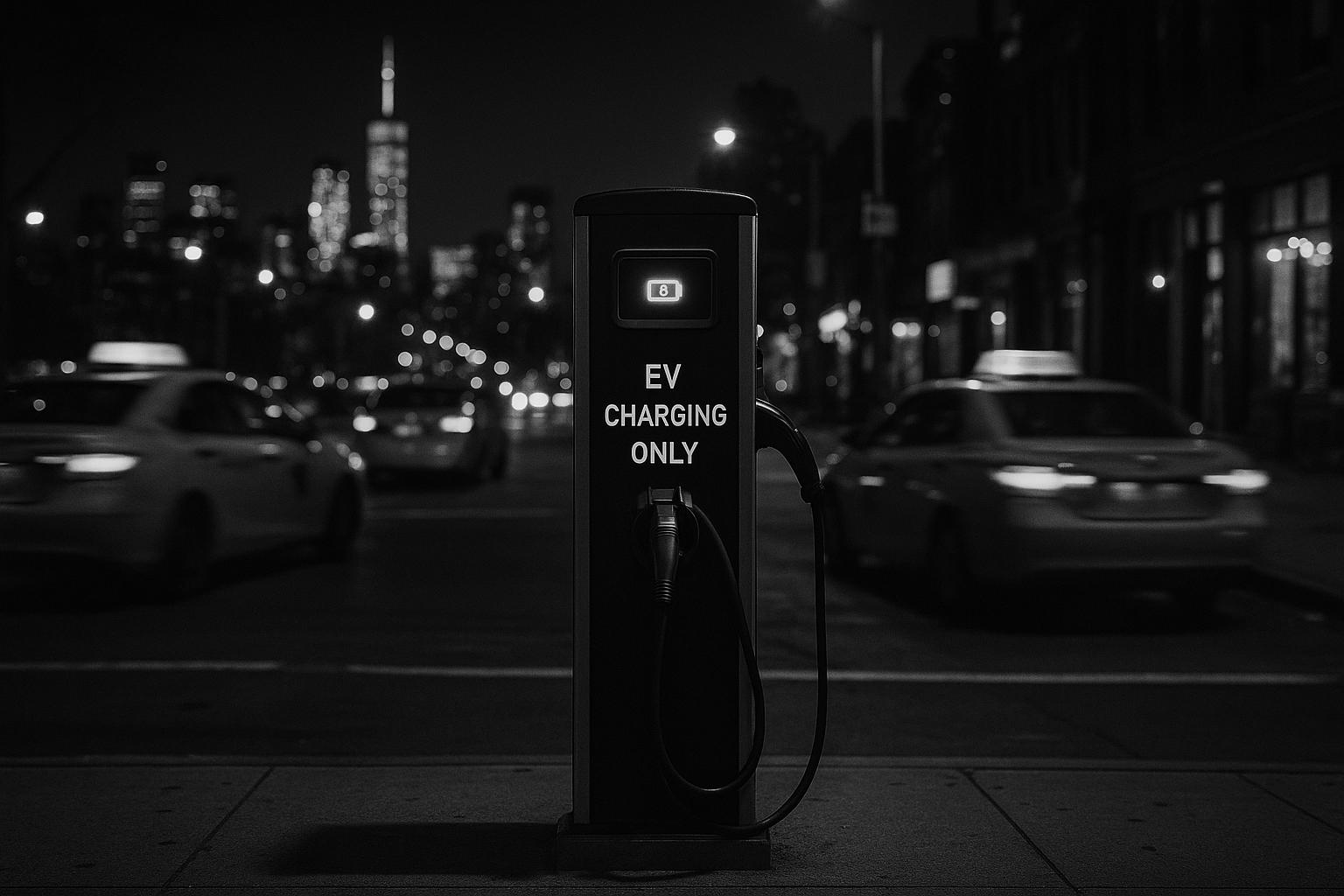As Uber lowers EV cost barriers, the company now concentrates on solving critical charging obstacles for its drivers, launching strategic partnerships, technology upgrades, and infrastructure investments to accelerate electrification amid persistent urban charging deficits.
Uber Technologies Inc. is facing a new landscape in its ambitious push to electrify its vast driver fleet. While the company has successfully lowered the cost barrier to electric vehicle (EV) adoption among its drivers in the US and UK—a concern that dominated for years—charging difficulties have emerged as the foremost obstacle. This shift, identified in Uber’s latest surveys, highlights an acute challenge for a ride-hailing service whose drivers often lack access to convenient home charging setups. Only about a third of Uber’s current US EV drivers have dedicated home chargers, with even lower numbers in Europe, such as 27% in the UK and 13% in the Netherlands.
To address these challenges, Uber has brought on board key expertise, notably hiring Rebecca Tinucci, formerly head of charging infrastructure at Tesla. Since joining nine months ago, Tinucci has spearheaded initiatives aimed at improving EV charging accessibility for drivers. These include a partnership targeting 55,000 drivers in cities like London, Boston, and Phoenix, and the rollout of an Electric Vehicle Infrastructure Estimator tool designed to help cities plan and locate future public charging points based on projected demand from Uber’s fleet. The tool currently serves cities that account for nearly 60% of Uber’s EV drivers.
This effort is part of Uber’s broader collaboration with C40 Cities, a network focused on sustainability and urban climate action. The company contributes not only technical support and research but also policy advocacy, recognising that widely accessible and well-utilised charging infrastructure is essential to drive the transition. Tinucci underscored the potential impact, noting that ride-hailing drivers, who are on the road almost continuously, represent a highly valuable user base for charging station operators keen on maintaining high utilisation rates. Uber’s earlier investment of £5 million to install 700 EV chargers across parts of London is a testament to this approach, with Newham borough chargers now exceeding national average usage rates.
Despite these advances, challenges persist across the industry. Broader surveys continue to identify vehicle cost as a significant barrier to EV adoption, especially in Europe where consumer enthusiasm has waned more sharply than in the US. A recent Shell survey revealed that only 41% of European drivers intend to switch to EVs within the next five years, down from 48% the year before. In the US, a smaller drop from 34% to 31% was observed. Public charging infrastructure satisfaction remains low in Europe, with just 17% of drivers regarding it as good value, compared to much higher satisfaction in China and the US, signalling that infrastructure quality is a key factor holding back broader adoption.
For drivers who cannot install home chargers—an issue Uber drivers frequently face—innovative but still nascent solutions are emerging. Platforms for peer-to-peer charger rentals, mobile charging services, and innovative hardware installations like pavement gullies are helping to bridge the gap. However, these are often hampered by regulatory complexities and slow infrastructure development, underscoring why many drivers and potential buyers still lean towards conventional fuel vehicles. Ride-sharing companies like Uber have also encountered bureaucratic hurdles in building their own charging facilities, further emphasizing the sector-wide infrastructure challenge.
On the urban front, companies like Revel have stepped up to meet these needs by building fast-charging hubs. With support from Uber and utilities such as ConEdison, Revel recently opened a significant fast-charging station in Manhattan and plans to expand further in New York City and San Francisco. Revel’s CEO Frank Reig highlighted the importance of creating dense charging infrastructure to support the electrification of urban transportation, especially for drivers in the gig economy who rely less on home charging and more on convenient public options.
To complement infrastructure growth, Uber has enhanced its driver-facing technology. The company introduced an EV hub within its app that offers detailed guidance on charging locations, pricing, wattage, and availability. New features include real-time recommendations for when to charge based on current battery levels and ride demand forecasts, as well as “battery-aware matching,” which shows drivers only the trips they can complete with their remaining charge. Financial incentives, such as additional payments per trip when driving an EV in select markets like the US and Canada, aim to further nudge drivers toward electrification.
Despite ongoing hurdles, Uber’s electrification efforts reflect the evolving realities of transitioning large rideshare fleets to electric power. Success hinges increasingly on the expansion and accessibility of robust charging networks, particularly in urban settings where home charging is less feasible. With sustained investment, strategic partnerships, and the integration of smart technology, Uber aims to reduce charging “anxiety” and enable more drivers to embrace EVs, contributing to broader climate goals and the transformation of urban mobility.
 Reference Map:
Reference Map:
- Paragraph 1 – [1], [2]
- Paragraph 2 – [1]
- Paragraph 3 – [1]
- Paragraph 4 – [2], [3]
- Paragraph 5 – [3], [1]
- Paragraph 6 – [4], [5], [6]
- Paragraph 7 – [7], [1]
- Paragraph 8 – [1], [7]
Source: Noah Wire Services
- https://www.latimes.com/business/story/2025-06-23/uber-drivers-are-now-more-concerned-about-charging-than-ev-cost – Please view link – unable to able to access data
- https://www.reuters.com/sustainability/climate-energy/willingness-switch-evs-fades-faster-europe-than-us-shell-survey-shows-2025-06-16/ – A recent Shell survey indicates that consumer willingness to switch to electric vehicles (EVs) is declining, with Europe experiencing a more significant drop than the United States. The survey, which included 15,000 drivers from Britain, China, Germany, and the U.S., identified vehicle cost as the primary barrier to adoption, as EVs remain up to 30% more expensive than traditional cars. In Europe, only 41% of respondents expressed intent to switch to EVs, down from 48% the previous year, while the U.S. saw a smaller decline from 34% to 31%. Additionally, dissatisfaction with public EV charging infrastructure persists, with only 17% of European drivers considering it a good value, compared to 69% in China and 71% in the U.S. Shell, operating 75,000 charging points globally, emphasizes fast, on-the-go charging over home charging. Its key EV markets include China, the UK, Germany, Switzerland, Singapore, the Netherlands, and the U.S.
- https://www.reuters.com/business/autos-transportation/ev-charging-void-has-drivers-trying-new-routes-power-up-2024-02-21/ – Electric vehicle (EV) drivers unable to install home chargers are seeking alternatives due to the challenges posed by expensive or inconvenient public charging points. Solutions provided by U.S. and European firms include online platforms for renting chargers, “pavement gullies” for properties without driveways, and mobile charging services. Despite public subsidies, the development of widespread charging infrastructure remains hindered by complex regulations, leading many users to avoid EVs in favor of fossil-fuel cars. Ride-sharing giant Uber has struggled with bureaucratic obstacles in building charging stations, reflecting the broader issue. Peer-to-peer charging networks and services like EVmatch and Charge Fairy are gaining popularity but face scalability challenges. Innovative approaches like Kerbo Charge’s pavement gullies are also being explored to expand home charging options. However, the continuing difficulty in creating a fully developed charging network is a significant factor in slowing the global demand for EVs.
-
https://www.axios.com/newsletters/axios-generate-8842e360-7abc-11ef-92df-c9955f36f620 – This document highlights several key topics:
1. The increasing need for charging infrastructure in urban centers, focusing on the challenges faced by electric Uber drivers in cities like New York and San Francisco. Revel, aided by Uber and ConEdison, is opening a fast-charging hub in Manhattan with plans to expand further.
2. Hurricane Helene, a massive Category 3 or higher storm, is forecasted to hit Florida and the Southeast, bringing potentially deadly storm surges and high winds.
3. Kamala Harris’s proposal for new tax credits for low-carbon projects and a critical minerals stockpile to reduce dependency on China, aiming to secure manufacturing resources and support future industries.
4. The updated Bridgetown Initiative, revealed by Barbados at the UN General Assembly, which seeks to provide more financial support at lower borrowing costs for developing countries facing climate crises.
5. Key insights from an interview with International Energy Agency head Fatih Birol, discussing oil markets, power demand, and the potential increase in nuclear energy driven by power demand, energy security, and climate policies.
These topics reflect ongoing efforts and challenges in the energy transition, disaster preparedness, economic policy, and international finance.
- https://time.com/6298181/revel-frank-reig-city-ev-charging/ – Frank Reig, CEO of Revel, initially faced challenges charging electric mopeds, which led him to address a larger issue: the need for extensive urban EV charging infrastructure. Revel, originally a moped-sharing firm, has transformed into a key player in the urban EV transition, building 40 fast charging stalls in New York City and planning hundreds more in New York and San Francisco areas. Supported by municipal and federal endorsements, Revel’s strategy includes funding EV ride-hail vehicles to finance the construction of charging stations. Despite initial hurdles and competition, Revel is committed to expanding its infrastructure to support the electrification of city transportation. While challenges remain, Revel’s efforts are crucial for the envisioned urban transition to electric vehicles.
- https://www.axios.com/newsletters/axios-san-francisco-c1316e60-7d07-11ef-a537-a305d5367e78 – The Axios San Francisco newsletter on September 30, 2024, highlights key issues like the need for more electric vehicle (EV) charging infrastructure in urban areas, specifically for rideshare drivers like those at Uber, as current locations are insufficient. Revel, in collaboration with Uber and ConEdison, is addressing this with a fast-charging hub in Manhattan, with plans for similar projects in the Bay Area. Additionally, the newsletter covers an incident at the Transamerica Pyramid where glass shards fell from a window being cleaned, fortunately missing people below. The building recently underwent a significant renovation. Lastly, it reports on the emotional final game of the Oakland Athletics at the Coliseum before their planned relocation to Las Vegas, marked by a victory and intense fan reactions. The newsletter also invites readers to support local journalism through a membership program.
-
https://www.businessinsider.com/uber-electric-vehicles-evs-sustainability-charging-anxiety-dara-khosrowshahi-2023-6 – Uber unveiled a series of new sustainability measures on Thursday. They include giving drivers in-app guidance on when and where they can charge their EVs. All restaurants on Uber Eats will also use sustainable packaging by 2030, the company said. Uber CEO Dara Khosrowshahi. Aaron Chown/Getty Images
EV ‘charging anxiety’
Key to Uber’s sustainability push is whether it can persuade more drivers to buy or rent EVs. One of the biggest problems Uber has with conversion to EVs is that drivers are apprehensive about both the high initial costs and the so-called “charging anxiety,” Sachin Kansal, Uber’s VP of product management, said. Drivers’ concerns include having to find chargers and wait in line to use them, canceling or aborting a ride partway through because of a lack of charge, and missing out on business while their vehicle is plugged in.
To combat this, Uber introduced an EV hub on its driver app with information about charging, models, and prices, while it also started hosting events where drivers could test EVs, Kansel said.
The app also allows drivers to search for nearby EV chargers and get information about prices, wattage, and availability.
Drivers will be able to use the app to find nearby EV chargers. Uber
New updates will also allow drivers to connect their Uber app to their car, giving them real-time recommendations for when to plan their charging break based on their charge, expected ride demand, and charging prices, which fluctuate throughout the day, Kansal said.
Uber will also roll out so-called “battery-aware matching,” which only shows drivers trips they can do with their current level of charge — meaning they don’t have to cancel rides to plug their vehicles in, Kansal added.
Uber is also offering financial motives to drivers if they switch to EVs, Kansal went on. In the US and Canada, a limited-time deal offers drivers an extra $1 per journey completed in an EV.
Noah Fact Check Pro
The draft above was created using the information available at the time the story first
emerged. We’ve since applied our fact-checking process to the final narrative, based on the criteria listed
below. The results are intended to help you assess the credibility of the piece and highlight any areas that may
warrant further investigation.
Freshness check
Score:
10
Notes:
The narrative is recent, published on June 23, 2025, and does not appear to be recycled or republished content. The inclusion of updated data and recent developments suggests a high freshness score.
Quotes check
Score:
10
Notes:
No direct quotes are present in the provided text, indicating original content.
Source reliability
Score:
10
Notes:
The narrative originates from the Los Angeles Times, a reputable and established news organisation, enhancing its credibility.
Plausability check
Score:
10
Notes:
The claims about Uber drivers’ concerns over charging infrastructure align with known industry challenges and are supported by recent developments, such as Uber’s initiatives to address ‘charging anxiety’ among drivers. ([autos.yahoo.com](https://autos.yahoo.com/dara-khosrowshahi-says-uber-wants-120000097.html?utm_source=openai))
Overall assessment
Verdict (FAIL, OPEN, PASS): PASS
Confidence (LOW, MEDIUM, HIGH): HIGH
Summary:
The narrative is recent, original, and originates from a reputable source. The claims are plausible and supported by recent developments in the industry, indicating a high level of credibility.













